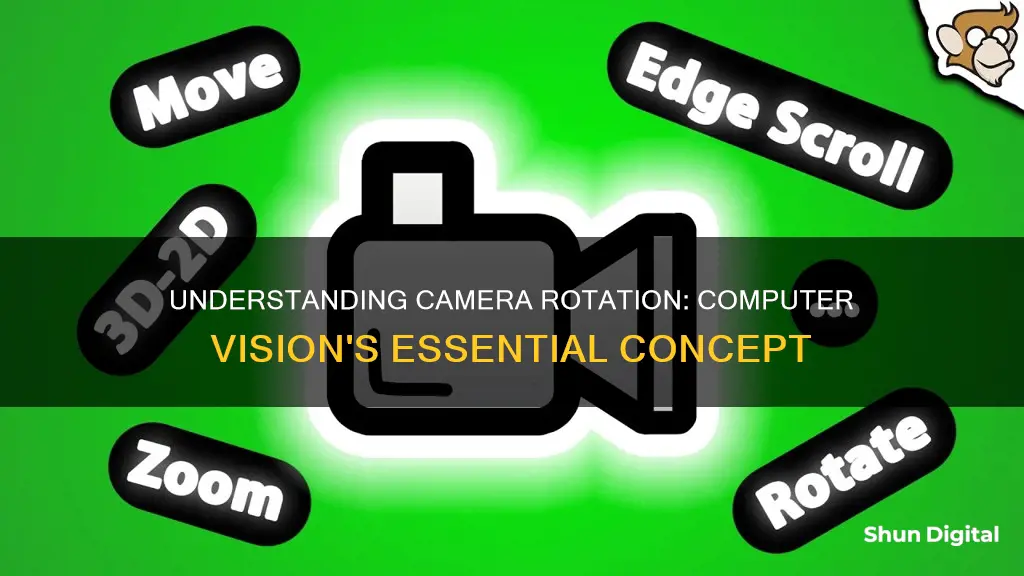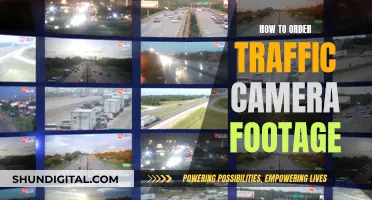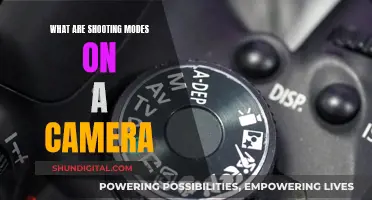
Camera rotation is a technique used in filmmaking and photography to create unique shots and capture specific scenes. It involves moving the camera horizontally, vertically, or on its side, resulting in energetic and dynamic shots. In filmmaking, common terms used to describe camera rotation include panning and tilting, which refer to horizontal and vertical rotations, respectively. In terms of computer software, camera rotation can be adjusted through built-in camera apps or external software, although some software may not offer this feature. Additionally, rotating line cameras are a type of digital camera that uses a linear CCD array to assemble digital images during its rotation.
What You'll Learn

Camera rotation in film
Camera rotation is a fundamental aspect of cinematography, encompassing various common movements that aspiring filmmakers should understand. One of the most basic forms of camera movement involves rotating the camera horizontally from left to right, which is known as panning or a "pan". This technique is often used to follow a character's actions or reveal new information, and it can be achieved using a tripod, a camera stabilizer, or even handheld. A "whip pan" is a variation of this technique, involving a fast horizontal pan that adds energy to a shot and establishes a dynamic connection between the characters and the audience.
On the other hand, rotating the camera vertically, either up or down, is called "tilting". Tilting is often used to convey a sense of character dominance or to introduce new elements to the audience. It is particularly effective in capturing the grandeur of tall objects or structures, such as buildings. Tilting can also be employed to create a sense of awe in the audience, as seen in Steven Spielberg's "Jurassic Park" when the dinosaurs are first introduced.
Another important camera rotation term is the "camera roll", which involves rotating the camera over its side along its long axis. This technique creates a dizzying effect, often used to evoke a sense of unease or tension in the viewer. It is intentionally disorienting and should be reserved for moments when a filmmaker wants to elicit discomfort. An example of this can be seen in "Black Panther" when Killmonger takes the throne, mirroring the sense of uneasiness in Wakanda.
In addition to these rotational movements, there are other types of camera movements that filmmakers can employ to enhance their storytelling. These include the "dolly zoom", which involves moving the camera toward or away from a subject while simultaneously zooming in the opposite direction, creating a sense of supernatural force or internal conflict. The "tracking shot" involves moving the camera through the scene, often following a travelling subject, and can be achieved using a dolly or a modern Steadicam. The "arc shot" moves the camera in an arc pattern around a subject, adding energy to the scene, as seen in Christopher Nolan's "The Dark Knight" during the Joker's menacing scenes.
Focusing Camera on Yourself: Tips for Perfect Self-Portraits
You may want to see also

Rotating line cameras
A prototype rotating line camera system typically consists of a colour tri-linear CCD camera, a fish-eye lens, and a rotating stage. The camera's projection model can be modelled as a spherical projection, with the lens centre aligned with the centre of the camera's rotation to achieve a single viewpoint.
One of the key advantages of rotating line cameras is their ability to capture high-resolution, full-spherical panorama images. This is achieved by using a fish-eye lens, which captures a slice of the spherical image with each rotation. By rotating the camera around the principal point of the lens, a full spherical image can be captured.
However, one challenge with rotating line cameras is the calibration process. Traditional camera calibration methods, such as Tsai's method, are not directly applicable to rotating line cameras due to their unique perspective projection and the need for a large calibration pattern to cover the wide field of view. Researchers have proposed various calibration methods, including point-based, image correspondence, and parallel-line-based approaches, to address this issue.
The price of rotating line cameras is currently high, but this is likely due to the small market size. With the growing demand for VR and panoramic video capture, it is expected that more affordable hardware will become available in the future.
Understanding Camera Raw: Processed or Not?
You may want to see also

Camera roll
In addition to these basic forms of camera rotation, there are also more advanced techniques. For example, a rotating line camera is a type of digital camera that uses a linear CCD array to assemble a digital image as the camera rotates. This technology is capable of capturing data at extremely high speeds and resolutions, making it useful for various applications, including parcel handling and high-speed sports imaging.
When it comes to rotating camera feeds from devices like webcams or IP surveillance cameras, the process can be more complicated. While some software and camera applications offer built-in rotation settings, others require more creative solutions. In some cases, it may be necessary to use third-party software or even command-line tools to achieve the desired rotation. Additionally, rotating a camera feed can distort the image and change the aspect ratio, which may be undesirable in certain situations. As such, it is generally recommended to physically rotate the camera itself whenever possible.
Surveillance Cameras: Block Their View, Regain Your Privacy
You may want to see also

Panning and tilting
Panning
Panning is a technique where the camera is rotated horizontally from a fixed point, either left or right. This movement is called a "pan". The word is derived from "panorama", reflecting how the camera pans across a scene to capture a wider view. Panning can be achieved in several ways, including using a tripod, a camera stabilizer, or even handheld panning. It is a subtle yet powerful tool for filmmakers, as it does not tend to draw the audience's attention, allowing them to remain immersed in the film.
Panning is often used to establish the location of a scene, providing a panoramic view of the setting. It can also elevate tension in a scene, allowing the audience to experience the moment in real-time and build anticipation. Additionally, panning can be used to reveal information about a character or the narrative. For example, a 360-degree pan of a character's room can communicate their interests and backstory.
Tilting
Tilting, on the other hand, involves rotating the camera up or downward in a vertical plane while the camera remains in a fixed position. This movement is similar to someone raising or lowering their head to look up or down. Tilting can be used to create a sense of character dominance, reveal new elements in the scene, or capture the vertical awe of a location, such as tall buildings.
Tilting can also be used as a reveal, leading the audience's gaze from one element to another, such as from a murder victim to the weapon and eventually to the killer's identity. It can be an effective way to establish a shot, such as tilting down from a tall landmark to the characters in the scene. Additionally, tilting can be used to express attention or head motion, such as a nodding "yes".
Combining Panning and Tilting
Action Camera Car Mode: What's the Deal?
You may want to see also

Software to rotate camera images
Camera rotation refers to the movement of the camera achieved through panning, tilting, or rolling. Panning is when the camera is rotated horizontally, tilting is when it is rotated vertically, and rolling is when the camera rotates over its side, creating a dizzying effect.
When it comes to software to rotate camera images, there are several options available. Here is a list of some software and applications that can help you achieve this:
JPEG Lossless Rotator
JPEG Lossless Rotator is a free and simple software that allows you to rotate digital photos to the correct orientation. Unlike other tools that decode and re-encode the JPEG image, resulting in a loss of quality, JPEG Lossless Rotator performs a lossless block transformation to preserve the image quality. It offers both an installer version and a portable version, supporting Windows 7, 8, and 10. The software also has a multilingual interface and is easy to use even for inexperienced computer users.
Fotor's Picture Rotator
Fotor's online image rotator lets you rotate your photos in 90, 180, 270, and 360-degree increments. It supports various image formats, including JPEG, JPG, PNG, WebP, HEIC, and HEIF. Fotor's rotator is accessible through any web browser and allows you to straighten and adjust the angle of your photos with ease.
PhotoDirector
PhotoDirector is a free mobile application available on iOS and Android devices. It offers a simple and user-friendly interface for rotating your photos. You can rotate your images in 90-degree increments or make precise adjustments down to the degree. In addition to rotation, PhotoDirector provides a wide range of editing tools, such as cropping, adding animations, removing objects, and changing backgrounds.
Apple Photos
Apple Photos is a free application that comes standard on all iOS devices. It includes essential editing tools, such as crop, rotate, and mirror functions. The app also features a slider for precise photo edits and automatic album creation to help you manage your media. Apple Photos is perfect for simple edits and using filters and advanced colour tools.
Google Photos
Google Photos is a photo and video management application available on both iOS and Android. It offers a simple and intuitive interface for rotating your images. You can rotate photos in 90-degree increments and make minor adjustments using a dial. Google Photos also provides free storage, smart albums, and additional editing tools for creating GIFs, collages, and slideshows.
PicGizmo
PicGizmo is a fast and straightforward mobile application for iOS and Android devices. It allows you to rotate, flip, and resize photos. The rotate icon is prominently displayed on the screen, making it easy to access. However, it is important to note that PicGizmo only rotates photos in 90-degree increments, and there are limited photo editing options available.
Rotate Image【Turn Image】
Rotate Image【Turn Image】 is a simple and straightforward mobile application for Android devices. Its sole function is to rotate photos, and it does not include any additional features. The app allows you to rotate images in 90-degree increments, changing the orientation from portrait to landscape or vice versa.
Reducing Camera Focus Length: Tips for Better Photography
You may want to see also
Frequently asked questions
Camera rotation is the movement of a camera on its vertical or horizontal axis. This can be done physically or, in the case of digital cameras, by altering the orientation of the captured image.
Some common camera rotation terms in film include "panning" and "tilting". Panning refers to the horizontal rotation of the camera, while tilting refers to vertical rotation.
You may need to rotate your camera if it is mounted in an unusual position, such as on its side. Rotating the camera can help ensure that the captured image is oriented correctly.
The method of rotating your camera feed will depend on the hardware and software you are using. In some cases, you may be able to use imaging software to digitally rotate the feed. In other cases, you may need to physically rotate the camera itself.
Yes, digitally rotating a camera feed can distort the image and change the aspect ratio. It is generally recommended to physically rotate the camera if possible to avoid these issues.







